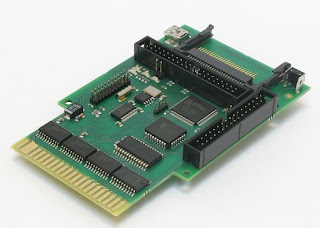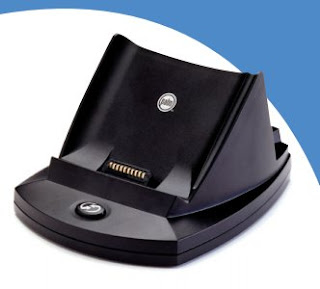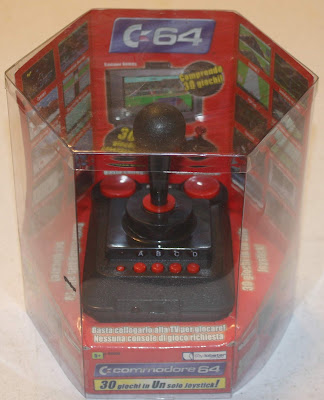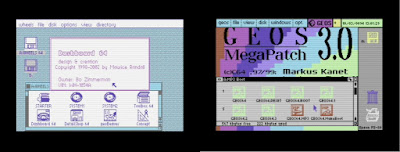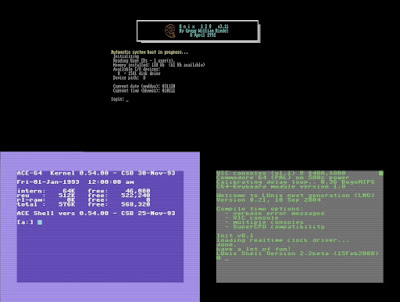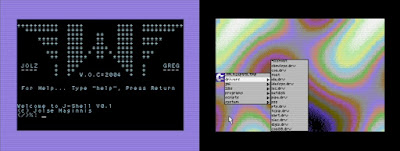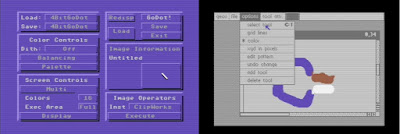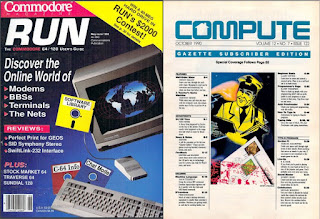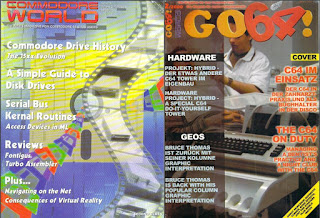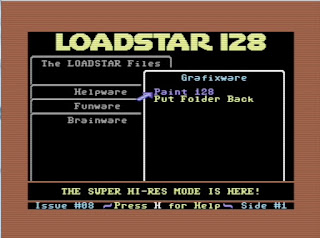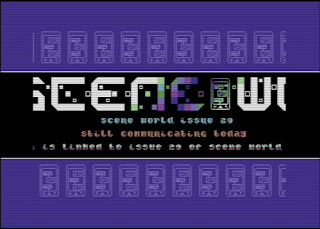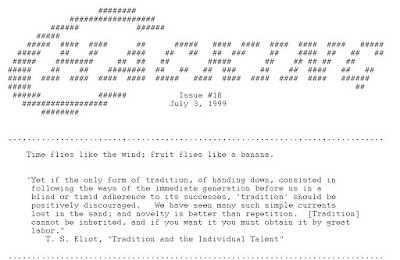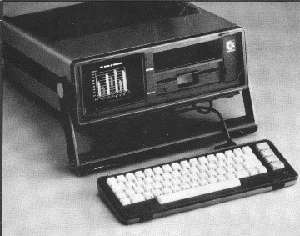However, I've observed a kind of awareness gap in the prodigal sons who've been returning to the fold. I decided, therefore, to write a little essay to get everyone who was absent from the 8-bit community during the 1990s and 2000s caught up.
For fellow die-hards: if I neglected anything, please comment below. This will understandably be written with a U.S. bias, though I did my best to overcome it.
And with that, let's get started.
Part 1: Hardware
For the Commodore 8-bit scene, the 1990s cannot be understood at all without talking about a little company founded by Doug Cotton and Mark Fellows in Massachusetts called Creative Micro Designs. From 1987 - 2001, CMD made us feel like our machines were more a lifestyle choice than clinging to obsolescence. Their products included the Kernal upgrade JiffyDOS, the SuperCPU 20mhz accelerator, HD-Series hard drives, FD-Series high density and enhanced density 3.5" floppy drives, the RAMlink ram drive, Smart-series mice and trackball controllers, gamepads, 1750 ram expansion clones (with 2MB!), and don't forget the SIDSymphony sound expander, and the SwiftLink and Turbo232 high speed serial/UART cartridges they licensed from Dr. Evil Labs.
While CMD towered over the 90s, they weren't entirely alone in their efforts to give Commodore power users new capacity. Tomas Pribyl and Jan Vorlicek developed the IDE-64 in 1994, a cartridge-based IDE controller that bragged better performance and a lower price, at the expense of compatibility, for mass storage.
Another option that emerged in the 90s was 64NET from Paul Gardner-Stephen, which allowed a PC to be used as a storage device for a C64. Around 2000, a similar solution called 64HDD, was devised by Nick Coplin.
As the internet began to take off in the mid-90s, new products began to emerge to solve the most pressing and important problem of the day: how to get software from the internet onto floppy disks. This led to various cables and solutions for connecting Commodore floppy drives to internet-enabled PCs in order to transfer software, primarily using Joe Forster's Star Commander software. These cables began with Leopoldo Ghielmetti's X1541 cable in 1992, which eventually expanded to include the XM1541, XE1541, and so forth.
Not to be left out, however, these dark ages also saw the first devices for getting 8-bits onto the internet directly. Initially this was through dial-up modems, often involving the aforementioned SwiftLink cartridge. Eventually, the wired-ethernet solution RR-Net was introduced by Jens Schönfeld as an add-on for the Retro-Reply cartridge, although software support has always been somewhat slim for this device. An even stranger solution was the Palm Pilot ethernet cradle, which, when combined with the SwiftLink cartridge, also allowed wired ethernet capability.
At the beginning of the new millennium, though, the scene's attention was turned to a young self-taught engineer named Jeri Ellsworth, who promised to bring us something previously un-imagined: a new hardware reproduction of the Commodore 64. By re-implementing each of the computer's custom chips in FPGA technology, this culminated in the CommodoreOne (C-One) computer. Not many years later, this same technology was scaled back in the form of the C64 DTV game. The DTV was famously designed to be hacked in such a way as to include ports for a keyboard and second joystick, and a serial port for disk drives, allowing it to be turned into a useful computer.
Part II: Software
Above is a screen shot of the Weekend World demo by Outcast. The interregnum Commodore demo scene saw a decline in the number of releases, though not in their quality. By the year 2000, the scene was producing 10% of what it had in 1990, but all of it building on the technological achievements of their predecessors. Output remained steady through 2009 before finally dying off in the last 10 years. The demo scene, especially in Europe, was the social center of Commodore 8-bit fandom. "The Scene" as it was called, was organizing itself into yearly and bi-annual "Parties" all over the continent.
Meanwhile, the same period saw intense interest among die-hard 8-bitters in new operating systems and platforms to take advantage of new hardware, new innovations in user interfaces, and, of course to access the internet. Chief amongst these was the graphical user interface GEOS and its Trinity of Successors.
Although Creative Micro Designs often released patches and utilities to help users of Berkeley Softwork's GEOS 2.0 enjoy their new hardware, it became quickly apparent, even to CMD themselves, that a more integrated solution was required. First out of the gate with such a solution was CMD themselves, with gateWay. Written by Jim Collette, gateWay featured integral support for CMD hardware, a task switcher, and a highly customizable (albeit unattractive) deskTop.
The next leg of the trinity to arrive was Maurice Randall's "Wheels" (GEOS 4.0) OS. Wheels sported movable and re-sizable windows, and support for CMD native partitions and sub directories in its beautiful "Dashboard" replacement for deskTop. This was quickly followed by GEOS MegaPatch3 by Markus Kanet in Germany, which included TopDesk 64, and, like gateWay, included integrated task switching.
While the GEOS patches remained a popular platform, UN*X clones for the 8-bits began arriving as well. First up was LUNIX in 1993 by Daniel Dallmann, which featured pre-emptive multitasking, pipes, and support for SLIP, PPP, and featured several network clients. The same year, Craig Bruce released his own ACE r9 for the C64 and C128, along with ZED-128 text editor, capable of handling enormous text files. Greg Reidel's UNIX-128 for the Commodore 128 rounds out our list.
As the year 2000 rolled around, Jolse Maginnis brought us an OS for the CMD SuperCPU, called WiNGs. It's object was to give the c64 support for the latest audio and video encodings, as well as extensive support for internet connectivity.
Our final entry in the OS bundle came in 2003, when Adam Dunkels released Contiki OS for all manner of Commodore 8-bits, as well as other platforms. Another GUI OS, Contiki was significant as a vehicle for RR-Net cartridges, by including a native tcp/ip stack as well as several internet servers and clients. Every 8-bitter wanted to run a web server on their C64 that year.
Software which ran on the standard Commodore kernal was also plentiful during this period, and helped us stay tentatively connected with advances in the PC-world. This included Pasi Ojala's "gunzip" in 2002 and "puzip" in 2004, Errol Smith's "UnZip64 v2" for handling pkzipped archives in 1998, and David DeSimone's "uuxfer" for decoding programs off of USENET.
New graphic formats popularized in the 90s also got support on our little 8-bits, include JPEG with JPX viewer by Stephen Judd in 1999, GIF files with VGIF viewer by David Jansen in 1990, and geoGIF by Randy Weems for GEOS the same year. Photos became a particular fascination with C64 users with the invention/discovery of dozens of new video modes one could achieve with the VIC-II chip, such as FLI, IFLI, and all the derivatives that emerged between 1990 and 2010.
There were also advances in image creating and editing software for the 8-bits as well. This includes the amazing GoDot system for the C64 released in 1996 by Arndt Dettke, as well as IPaint for the Commodore 128 in 1993 by Rick Kane. And of course, there is no way GEOS would be outdone on image editing, which made the release of geoCanvas by Nate Fiedler in 1993 quite an event.
And lastly, as the BBS scene gave way to the internet, serial terminal programs capable of 80 column display and ANSI grew in importance for 8-bit computer users using dial-up shell accounts. This made the release of Novaterm 9.6 by Nick Rossi in 1997 an extremely welcome development for C64 users. On the Commodore 128, we all swore by DesTerm by Mathew Desmond in 1998.
Part III: Magazines
Magazines and other bundles of periodical content continued to play an important role in the interregnum, especially during the early 1990s when it was still our only way to find out what was going on in the Commodore world.
At first, the Glossy magazines, especially those hanging in from the 1980s, continued to keep us in the loop.
In the U.S., these would include RUN Magazine which continued until 1993, and COMPUTE! magazine, which included an internal "Gazette" section for 8-bitters until 1994. In their waning years, the content shifted a bit towards GEOS and the new CMD hardware, but otherwise kept their original focus.
Believe it or not, new glossy magazines also appeared after the old 1980s magazines vanished. Although many of them didn't last very long.
Creative Micro Design's own Commodore World, which ran from 1994-1999, picked up where RUN magazine left off and focused almost entirely on GEOS and their other products. Meanwhile, GO64!, a German language Magazine, was published by CSW Verlag from 1997-2000. GO64! also began publishing an English edition in 1999, and picked up the remainder of Commodore World's subscribers.
Also in Europe, the gaming magazine Commodore Format held strong from 1990 all the way through Commodore's bankruptcy in 1995. It remained intensely focused on cheat codes and strategies and tons of colorful screenshots all the way.
And of course, the magazine Die Hard ran for 20 issues, from 1992 to 1994, and started out as a monochrome newsletter to quickly build into a nice glossy magazine. It was published by LynnCarthy Industries in Idaho.
Magazines based entirely on disk have been around since the 1980s, and chief among those was the mighty LoadStar by Fender Tucker of SoftDisk Publishing, and later Dave Moorman. Known for publishing digital articles and original Commodore 64 programs, pictures, and music from independent contributors, LoadStar managed to hang on far longer than most. In 1990, LoadStar 128 joined its older brother as a Commodore 128 only publication, and they ran until 2007. The disk magazine was also accompanied by a paper magazine called the LoadStar Letter, which spawned another paper publication called The Underground by S. Eggleston of California.
Launched in 2001 by Joerg "Nafcom" Droege, Scene World has been publishing their interviews, articles, and software for both NTSC and PAL users ever since.
Another important disk magazines from this period is Commodore Gazette published by Christopher Ryan of Michigan, which ran from 1995 - 2004. It focused primarily on articles and public domain software.
Of course, its impossible to discuss periodicals from this period without discussing the several online newsletters published during this time. First and foremost among these was the mighty C= Hacking Magazine published by Craig Taylor, Jim Brian, and Steve Judd between 1992 and 2002. It focused on community innovations, programming techniques, and the hidden capabilities of our little 8-bits.
And lastly, although you've probably already heard of it, the online magazine Commodore Free was started back in 2006 by Nigel Parker, and didn't cease publishing new issues until 2017.
Part IV: Early Internet
The early days of the internet for Commodore 8-bit users could be summed up by USENET and FTP. Web sites did exist, but tended to be more like picture galleries and references than social media.
USENET was the early internet's standard Forums protocol, and allowed for networked computers to share plain-ascii text under group categories. It was THE social media of the 1990s for Commodore users.
The popular USENET groups for C= 8-bitters were called "comp.sys.cbm" and "comp.binaries.cbm".
The former was for announcements, conversation, trolling, and the occasional Speccy vs C64 flame war. It would be pretty familiar to any modern user browsing the old discussions, which you can absolutely do right now through google groups. Common refrains there include the FAQ postings by Cameron Kaiser, and few old timers will forget the ramblings of WildStar.
"comp.binaries.cbm" is a odd medium for sharing software, but that's what it was. Although on casual inspection it appeared to be another discussion forum, instead you'd find most of the messages were UUencoded ascii of various commodore related binaries, often broken up into several parts spanning several messages. An early unix shell account user would download the parts of the message, combine them, and translate them back from ascii -> binary before moving it over to a floppy for execution.
FTP sites constituted a more straight-forward method for sharing binary files on the internet, and several FTP sites sprang up during the 90s to serve the 8-bit community.
One early important site was the FUNET archives at ftp://ftp.funet.fi/pub/cbm. Maintained by Marko Mäkelä until 2005, funet was invaluable as a source of firmware for computers with dead roms, schematics for troubleshooting, as well as all the latest utilities and project documents to keep any 8-bit user busy. Since 2005, the archive has been at ftp://ftp.zimmers.net/pub/cbm
Videocam.net.au, run by the Australians Rod and Gaelyne Gasson, was another popular general purpose file area that seemed to have a little bit of everything.
When it comes to games, however, nothing beat arnold.c64.org and arnold.niof.no. So popular were these enormous collections of disk images that they were known simply as "The Arnold Archives".
Web sites, while not as important early on, were still seen as artistic monuments on a hill -- discussed when they changed, and little more. Many of these monuments remain to this day, while some have faded into memory. The Secret Weapons of Commodore has always been one of my personal favorites, as was the Commodore 8-Bit Server, the Commodore Knowledge Base, VIC-20 Digital Archaeology, Snakeman's page, Project 64, Zimmers.net, and the CBM-II Page -- but these are just a sample.
Part V: Sunset, or Sunrise?
The last decade has seen impressive leaps of renewed interest in Commodore 8-bit computing. New storage devices, new networking solutions, new display options, new computers, and piles of new games and software that seems to have come out of nowhere. It's almost like the 1980s are completely back again.But between 1990 and 2010, the 8-bit community marched onward, even as we watched former comrades fall away. I think it's useful to remember that period, both to reflect on the problems we faced, and on all that was built as a foundation for what we would all enjoy today in our little 8-bit hobby.


